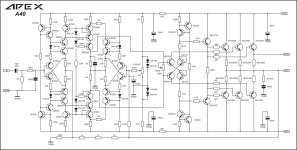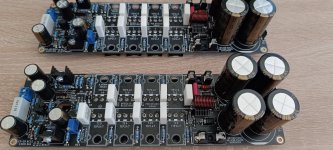Hi there,
I'm new here and don't know if any better place to ask here.
I'm looking for an amplifier to build that can drive my custom made 300W 4ohms floor standing speaker,
I'm looking forward to Apex A40 design,
Any updated or better suggestions?
Thanks in advance
(Attaching A40 schematic)
I'm new here and don't know if any better place to ask here.
I'm looking for an amplifier to build that can drive my custom made 300W 4ohms floor standing speaker,
I'm looking forward to Apex A40 design,
Any updated or better suggestions?
Thanks in advance
(Attaching A40 schematic)
Attachments
Hi, one thing to check is the maximum power you plan to have.
3x2SC5200 @ 4ohm are good for 200W maximum in class AB, so as to be within the safe operating area with Tcase at 80C, for example considering a real reactive load (speaker).
What power supply voltage do you plan to apply to this amp?
3x2SC5200 @ 4ohm are good for 200W maximum in class AB, so as to be within the safe operating area with Tcase at 80C, for example considering a real reactive load (speaker).
What power supply voltage do you plan to apply to this amp?
Last edited:
Around ±60VDC depending on the Amplifier,
I can build any transformer if more or less is required,
If required I can rebuild the circuit for 2 pairs of each 5200 and 1943
I don't like going class-d unless for subwoofers
I can build any transformer if more or less is required,
If required I can rebuild the circuit for 2 pairs of each 5200 and 1943
I don't like going class-d unless for subwoofers
...an amplifier to build that can drive my custom made 300W 4ohms floor standing speaker...
300W is the maximum recommended power for the speaker. This means that any amplifier up to 300W would be OK, assuming you use the full power capability of the amplifier. It's typically better to choose an amplifier that has too high a power rating than too low, and amplifiers up to 100W into 8 Ohms are common. Maybe you knew all this, and maybe not, so I thought I would start with this info.
About the amplifier: I assume you are looking to build from a PCB a class-AB amplifier? You really did not say much about your needs or goals, or amplifier building experience. Perhaps you could provide some more info so that people can better help you choose...
Yes Charlie I want to build a PCB (two of em infact for both channel)
My use case is just for home audio.
I'm just looking for some similar designs like apex,
I have experience with their SR200, really good sounding stuff
My use case is just for home audio.
I'm just looking for some similar designs like apex,
I have experience with their SR200, really good sounding stuff
I would also at speaker sensitivity, room size, and how loud you want the loudest continuous sound.
Then perhaps work for 3-6dB headroom.
I.e. 86dB/Watt, gives 89dB with 2W, 92 with 4W, 95dB with 8W, 98dB with 16W, 102dB with 32W etc.
Maybe run something into them so it's LOUD, and measure the average and peak voltage at the speaker terminals.
Then perhaps work for 3-6dB headroom.
I.e. 86dB/Watt, gives 89dB with 2W, 92 with 4W, 95dB with 8W, 98dB with 16W, 102dB with 32W etc.
Maybe run something into them so it's LOUD, and measure the average and peak voltage at the speaker terminals.
You have to match the number of 5200/1943 in paralel with the planned power @ 4ohms.Around ±60VDC depending on the Amplifier,
I can build any transformer if more or less is required,
If required I can rebuild the circuit for 2 pairs of each 5200 and 1943
I don't like going class-d unless for subwoofers
If you use +/-60VDC no load, you''ll get around 50VDC with load and that will give you around 280W @4ohm.
The voltage drop may vary according to the transformer losses you have and how much close to power supply voltage this circuit can swing to.
I'm assuming 2V loss in the circuit.
For this power, I'd use 4 x 5200 + 4 x 1943 to be safe, so adding one pair on the original design.
I'm assuming real reactive load, so a speaker, where voltage and current could be 30 degree out of phase which is worse than resistive load.
The amp power will depend on how much SPL you need in your room (depend on how far you are from speakers, how big is your room, how much bass you like etc).
Nowadays, that I've got older, with my ears worn out, I don't like SPL higher than 90 or 95 peak so, for me 80W amp (what I use) is more than enough with my speakers having 85dB sensitivity. But this is totally personal.
Do you have the sensitivity of your speakers and your desired maximum SPL?
AX40 is unnecessarlly complex. 40 transistors. You could buy 2 honeybadger boards (diyaudio store https://www.diyaudiostore.com/ ) change to MJL3281 MJL1302 output transistors and run more like 250 w out of it instead of 150 with the 2SC5200 2SA1943. Lots of heatsink of course, and perhaps a fan. Heat sinks on the driver transistors.
You live in the country where the developed world sends electronic waste to be scrapped. Make contact with a scrapper tell him you are looking for Peavey CS800 CS1200 PV-1.3k Crown XTI1200 XTI1600 MA1200 MA4200 XLS602 MA5000 QSC CS702 CX902 CX1102 MX1500 RMX2450 BGA750. That gets you a case, heatsinks, fan input output connectors all the expensive parts to make an amp. All those models have schematic diagrams on the internet. Peavey a semiconductor part # cross is available.
You live in the country where the developed world sends electronic waste to be scrapped. Make contact with a scrapper tell him you are looking for Peavey CS800 CS1200 PV-1.3k Crown XTI1200 XTI1600 MA1200 MA4200 XLS602 MA5000 QSC CS702 CX902 CX1102 MX1500 RMX2450 BGA750. That gets you a case, heatsinks, fan input output connectors all the expensive parts to make an amp. All those models have schematic diagrams on the internet. Peavey a semiconductor part # cross is available.
IIRC, also in a country where a single pair of ON MJL3281/1302 costs more than a house payment. And fake C5200/A1943 are all over the place for beer money.
I will agree that starting out with a dead hulk is the way to go - as long as the transformer is still good and can be strapped for operation at the voltage in your area. And that those “I’ll buy a vowel” circuits with 50 current mirrors aren’t all they are cracked up to be. They SIMULATE very well. But unless you’re going to go matching all the pairs, quads, or whatever is needed they are no better off than something simpler.
I will agree that starting out with a dead hulk is the way to go - as long as the transformer is still good and can be strapped for operation at the voltage in your area. And that those “I’ll buy a vowel” circuits with 50 current mirrors aren’t all they are cracked up to be. They SIMULATE very well. But unless you’re going to go matching all the pairs, quads, or whatever is needed they are no better off than something simpler.
Why not try some high end class-D?
ICEpower 1200AS2 will give you 2x700 watt @ 4ohm, with THD and noise levels lightyears below most class-A/AB amps. Everything is on 1 single PCB including power supply. Just connect mains power and the amp is running.
Currently these modules sells for 490USD.
ICEpower 1200AS2 link
ICEpower 1200AS2 datasheet

ICEpower 1200AS2 will give you 2x700 watt @ 4ohm, with THD and noise levels lightyears below most class-A/AB amps. Everything is on 1 single PCB including power supply. Just connect mains power and the amp is running.
Currently these modules sells for 490USD.
ICEpower 1200AS2 link
ICEpower 1200AS2 datasheet
I would suggest the wolverine.
A current, proven and well supported project in the sort of power level you desire.
A current, proven and well supported project in the sort of power level you desire.
- Home
- Amplifiers
- Solid State
- Amplifier suggestions for 300W~350W 4Ω tower speakers

